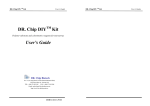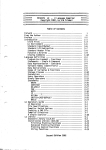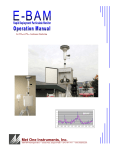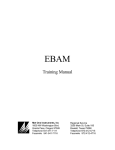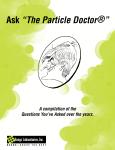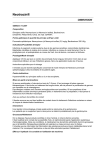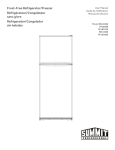Download DR. Food Kit User's Guide
Transcript
DR. Food TM Kit User’s Guide DR. Food TM Kit User’s Guide DR. FoodTM Kit DR. Chip Biotech No. 31, Ke Jung Road. Science-Based Park, Chu-Nan, Miao-Li, Taiwan 350 TEL: +886-37-585-585 FAX: +886-37-585-586 Email: [email protected] http://www.bio-drchip.com.tw User’s Guide DR. Chip Biotech No. 31, Ke Jung Road. Science-Based Park, Chu-Nan, Miao-Li, Taiwan 350 TEL: +886-37-585-585 FAX: +886-37-585-586 Email: [email protected] http://www.bio-drchip.com.tw DME-FP-0403-E DR. Food TM Kit User’s Guide DR. Food TM Kit User’s Guide DR. Food TM Kit Notes User’s Guide DR. Food TM Kit User’s Guide Contents 1.Kit Contents Specifications Description of products Storage conditions Precaution 2.Introduction Product characteristics Limitations 3.Procedures and required materials Materials required but not provided Procedure Ι.Sampling & preparation Ⅱ.Enrichment Ⅲ.DNA extraction Ⅳ.DNA amplification Ⅴ.Hybridization Ⅵ.Stringency wash Ⅶ.Colorimetric development 4.Results Pattern design principle Allocation of specific probes Interpretation of results 1 1 1 3 3 4 4 4 5 5 5 5 5 5 6 7 7 7 8 8 9 9 DR. Food TM Kit User’s Guide 1.Kit Contents Notes Specifications Part A: Storage at –20oC or below No 1 2 3 Contents PC DNA Pol. FM Volume 300 µL 55 µL 1.3 mL Quantity 1 Vial 1 vial 4 vials Volume 60 mL 200 mL 55 µL 60 mL 120 mL 1.2 mL 20 mL 1.3 mL 3 reactions Quantity 1 bottle 2 bottles 1 vial 1 bottle 1 bottle 1 vial 1 bottle 4 vials 32 packs Part B: Storage at 2-8oC No 1 2 3 4 5 6 7 8 9 Descriptions DR. HybTM Buffer Wash Buffer Strep-AP Blocking Reagent Detection Buffer NBT/BCIP E1 (10X, concentrate) E2 DR. Food Chip Description of products No 1 2 Reagent PC DNA Pol. DR. Food TM Kit Description Positive control DNA template of PCR PCR enzyme (5U/µL). 1 User’s Guide DR. Food TM Kit User’s Guide DR. Food TM Kit Allocation of specific oligonucleotide probes ● ● ● ●● ● ● ● ● ● ● ● ● ● ● ● ● ● ● ● ● ● ● ● ● Interpretation of results ● ● ● ● ● ● ● ● ● ● ● ● ● ● ● ● ● ● ● ● ● ● ● ● ● ● ● ● ● ● ● ● ● ● ● ● ● ● ● ● ● ● ● ● ● ● ● ● ● ● ● ● ● ● ● ● ● ● ● ● ● ● Hybridization Positive Control Staphylococcus aureus ● ● Salmonella spp. Escherichia coli - Shigella spp. ● ● ● Listeria monocytogenes Bacillus cereus Yersinia enterocolitica ● ● Vibrio spp. Clostridium spp. ● ● PCR positive control Negative control ● ● ● ● ● ● ● ● ● ● ● ● ● ● ● ● ● ● ● ● ● ● ● ● ● ● ● ● ● ● ● ● ● ● ● ● ● ● ● ● Staphylococcus Escherichia coli Listeria Salmonella spp. aureus - Shigella spp. monocytogenes ● ● ● ● ● ● ● ● ● ● ● ● ● ● ● ● ● ● ● ● ● ● ● ● ● Yersinia enterocolitica ● ● ● ● ● ● ● ● ● ● ● ● ● ● ● ● ● ● ● ● ● ● ● ● ● Vibrio spp. ● ● ● ● ● ● ● ● ● ● ● ● ● ● ● ● ● ● ● ● ● ● ● ● ● Clostridium spp. 9 ● ● ● ● ● ● ● ● ● ● ● ● ● ● ● ● ● ● ● ● Positive Control ● ● ● ● ● ● ● ● ● ● ● ● ● ● ● ● ● ● ● ● ● ● ● ● ● ● ● ● ● ● 3 FM 4 DR. HybTM Buffer 5 Wash Buffer 6 Strep-AP 7 Blocking Reagent 8 Detection Buffer 9 NBT/BCIP 10 E1 Bacillus cereus ● ● ● ● ● ● ● ● ● ● ● ● ● ● ● ● ● ● ● ● ● ● ● ● ● Negative Control User’s Guide PCR premix for amplifying specific target genes: Staphylococcus aureus, Escherichia coli, Yersinia enterocolitica, Clostridium perfringens, Bacillus cereus, Listeria monocytogenes, Salmonella spp., Shigella spp., Vibrio spp., and DNA internal control; the reagent contains specific 5’-biotinylated primer pairs, dNTPs, PCR buffer, and MgCl2. Specially formulated to facilitate hybridization of specific oligo probes with target DNA amplicons. Stringency wash to remove non-binding amplicons, after hybridization reaction. Using the specificity of biotin and streptavidin to detect the biotinylated molecules of amplicons. The streptavidin conjugated alkaline phosphatase as enzyme to react with its substrate NBT/BCIP for colorimetric signal on the chip. Specifically formulated to reduce non-specific nucleic acid binding on polymer chip surfaces, also as a dilution buffer for Strep-AP. A dilution buffer for NBT/BCIP, formulated to ensure Strep-AP activity. Chromogenic phosphatase substrates. Hydrolysis of BCIP (5-Bromo-4-chloro-3-indolyl phosphate indolyl phosphate), followed by oxidation, produces a blue-colored precipitate at the site of enzymatic activity. NBT (Nitro blue tetrazolium) is the most commonly used electron-transfer agent and co-precipitant for the BCIP reaction, forming a dark blue, precisely localized precipitate in the presence of Strep-AP. Remove the PCR inhibitor for bacterial culture medium. 2 DR. Food TM Kit 11 E2 12 DR. FoodTM Chip User’s Guide Extract genomic DNA from bacteria A platform for hybridization reaction. Its surface is pre-spotted with a variety of specific probes for target organisms. DR. Food TM Kit User’s Guide 2. Mix 10 µL NBT/BCIP with 490 µL Detection Buffer for each chip, transfer the mixture to the hybridization chamber. 3. Allow to react in the dark for 10 minutes at room temperature. 4. Discard the detection liquid, rinse the chip with 1 mL water twice and read the results of the pattern developed on the chip with DR. AiM Reader. 4. Results Storage conditions o o Please store Part A at -20 C or below, Part B at 2-8 C upon delivery. DR. FoodTM Kit has demonstrated stability over a 9 month period when stored at recommended temperatures; however, we recommend to be discard the kit after expiration date. Precaution Aliquot FM, DNA Pol., PC prior to use. Do NOT leave DNA Pol. at room temperature over 5 minutes. Only appropriately trained molecular laboratory personnel shall operate this system. All protocols in this manual shall be followed. Gloves shall be worn at all time. In case of contact with eyes, rinse eyes immediately with plenty of water. Do NOT touch the surface of the chip. Before using E1, add 180 mL sterile water to obtain 200 mL 3 Pattern design principle Results are interpreted by the pattern formed on the chip. Foodborne pathogen-specific oligonucleotide probes are designed and pre-spotted on the chip to capture specific target amplicons. After hybridization and colorimetric development, perfectly matched probe-target hybrid will form a blue-purple precipitate on the chip as a result of enzymatic reaction. Chip patterns are read and identified by DR. AiMTM reader together with analysis software (Refer to the DR. AiMTM Reader user’s guide). Diagrams below show the patterns of the DR. FoodTM kit. Note: A successful test will show the relevant spots for Hybridization Positive Control and PCR Internal positive Control. In the absence of the positive controls, please check the operation process carefully. 8 DR. Food TM Kit User’s Guide DR. Food TM Kit User’s Guide V. Hybridization Preparation for hybridization 2.Introduction Product Characteristics 1. 2. DR. FoodTM kit is a foodborne pathogen detection system for Staphylococcus aureus, Escherichia coli, Yersinia enterocolitica, Bacillus cereus, Clostridium spp. (Clo. perfringens and Clo. butulinum), Listeria monocytogenes, Salmonella spp., Shigella spp., and Vibrio spp.. The system provides more accurate test results than bacterial culture. DR. FoodTM kit system applies four molecular biology techniques: DNA extraction, PCR amplification, DNA hybridization and colorimetric development, using the following principle: The genomic DNA of the pathogens is extracted from bacterial enrichment culture and the target gene is replicated using PCR amplification technology. The amplicons are hybridized with specific probes, which are found on the chip. After hybridization, stringent washing removes non-target DNA fragments and residual amplicons. After subsequent colorimetric development, patterns will form on the chip corresponded to the pathogen within the food sample. Pre-warm DR. Hyb Buffer, Wash Buffer and chip to room temperature. Pre-heat hybridization oven to 45 oC. Hybridization Reaction 3. 4. 5. 6. Pipette 25 µL amplicons into 500 µL pre-warmed DR. Hyb Buffer and mix thoroughly. Denature mixture in boiling water for 10 minutes. Chill on ice for 3 minutes immediately, and then spin down. Transfer 500µL of hybridization mixture onto the DR. FoodTM Chip; incubate at 45 oC in the DR. Mini Oven with maximum vibration for 1 hour. VI. Stringency Wash 1. 2. 3. Discard the hybridization liquid. Add 500µL Wash Buffer into the hybridization chamber and then discard the wash liquid. Repeat this wash step three or four times. After step 2, invert the chip chamber and repeatedly tap on paper towel to remove any residual liquid. VII. Colorimetric Development Blocking 1 2. 3. 4. For each chip mix 0.5 µL Strept-AP with 500 µL Blocking Reagent; transfer the mixture into the chamber, allow to react for 30 minutes at 25~35 oC. Discard the reacted blocking liquid. Add 500µL Wash Buffer into the hybridization chamber and then discard the wash liquid. Repeat this wash step three or four times. After step 3, invert the chip chamber and repeatedly tap on paper towel to remove any residual liquid. Limitations DR. FoodTM kit is designed to detect nucleic acids of the foodborne pathogens, Staphylococcus aureus, Escherichia coli, Yersinia enterocolitica, Bacillus cereus, Clostridium spp. (Clo. perfringens and Clo. butulinum), Listeria monocytogenes, Salmonella spp., Shigella spp., and Vibrio spp.. The detection limit is listed below for bacteria after enrichment. Sensitivity Sensitivity Pathogen Pathogen ( cfu/mL) ( cfu/mL) Staphylococcus aureus Escherichia coli Yersinia enterocolitica Bacillus cereus Listeria monocytogenes 109 ~ 104 108 ~ 104 108 ~ 104 108 ~ 103 109 ~ 104 Salmonella spp. Shigella spp. Vibrio spp. Clostridium spp. Colorimetric Reaction 1. Rinse chip with 500 µL Detection Buffer and discard the liquid. 7 4 109 ~ 104 108 ~ 104 108 ~ 104 108 ~ 103 DR. Food TM Kit User’s Guide 3.Procedure and materials required Materials required but not provided Instruments -20℃ Freezer Micropipettes Vortex mixer TM Hot plate DR. AiM Reader DR. Mini Oven Microcentrifuge Thermal cycler (Suggestion : PTC-100/MJ Research ,Inc. ) Tips 1.5 mL microcentrifuge tubes Procedure I. Sampling & Preparation Sampling methods and preparation vary depending upon the type of food. Check national regulations for detailed methods of food sample preparation or use of the methods described in Food Sampling and Preparation of Sample Homogenate (Bacterial Analytical Manual Online, Chapter 1, http://www.cfsan.fda.gov/~ebam/bam-1.html) by FDA as reference. II. Enrichment 1. Add 25 mL or 25 g food sample in 225 mL LB broth (or other suitable medium), incubate at 37℃, 24 +/- 2 hours) 2. Carry out ten-fold dilution of this enrichment culture with sterile water before DNA extraction step. III. DNA Extraction • User’s Guide 4. Discard the supernatant, and resuspend the pellet with 50 µL E2; vortex until mixed well. 5. Heat in boiling water for 10 minutes; chill on ice for 2 minutes 6. Vortex the mixture and centrifuge at 8,000 g/ 4℃ for 5 minutes. 7. Take 50 µL supernatant, containing the isolated DNA, to a new 1.5 ml eppendorf tube ready for amplification. The extracted DNA can be stored at 4oC and used within 2 days. IV. DNA Amplification Consumables PCR tubes DR. Food TM Kit Before using E1, add 180 mL sterile water to obtain 200 mL 1. Transfer 1 mL of diluent, which was obtained from previous step, into a microcentrifuge tube and centrifuge at 8,000 g/ 4℃ for 5 minutes. 2. 3. Remove the supernatant, resuspend pellet with 1 ml E1 and mix gently. Centrifuge at 8,000 g/ 4 ℃ for 5 minutes 5 1. Preparation of PCR Master Mix. Transfer the following reagents into a PCR tube and mix thoroughly. For every batch of tests, prepare additional tubes for PCR negative control and positive control. Reagents Volume/tube # of tubes Total volume FM 39.5 µL × (n + 1) = ______µL DNA Pol. 0.5 µL × (n + 1) = ______µL ✪ n = number of sample (including PCR negative control and positive control) 2. Pipette 40 µL master mix into each PCR tube. 3. Transfer 10 µL extracted DNA sample into each tube, mix thoroughly; for PCR negative control, use 10 µL aseptic water and for PCR positive control, use 10 µL PC (positive control template) reagent. Final volume of each tube is 50 µL. 4. Place all PCR tubes in a Thermal Cycler and follow the amplification program listed below. 95 oC 5 min 95 oC 30 sec 60 oC 30 sec 30 cycles o 72 C 30 sec 72 oC 5 min 4 oC ~ 5. Proceed to hybridization reaction. ✪ If not used immediately, please store amplicons at -20 oC 6








